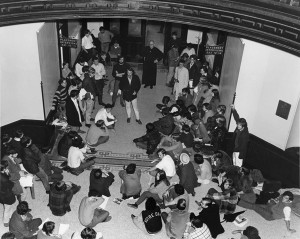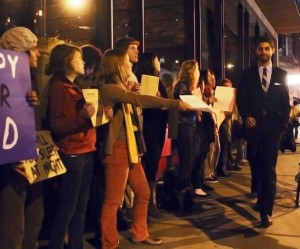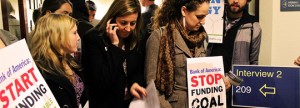
I had the great privilege of representing Rainforest Action Network at the student-led Power Up! Divest Fossil Fuels Convergence. Hosted by Swarthmore Mountain Justice, students from around the country gathered for conversations about movement culture and strategy. I was thrilled to find myself amidst a dynamic and emergent group that asked all the right questions: what does student autonomy look like? How can students use their privilege to act in solidarity with extraction communities and people on the front lines of climate impacts? How can students create the signifiers of a resistance culture, the songs and images that can sustain a movement for justice over the long term?
Compared with the campus climate activists of the past, the students of the divestment campaign have a certain edge. Currently united by a tactic consciously culled from the anti-apartheid movement of the 1960s, 70s and 80s, the campus divestment movement possesses an awareness of movement theory and history, past and present. The orange felt squares pinned to the divestistas’ chests are a riff from the Quebecois student uprisings, and demonstrate an intentionality and commitment to long-haul organizing that should inspire great hope for this movement. Divestment activists are aware that they stand on the shoulders of preceding justice movements, and look to history to inform their tactics.
All this to say, students and their opposition should prepare for escalation. Time and time again, campus-based movements for justice have embraced tactics that evolved from symbolic, polite appeals to the power structure to direct intervention in the same, especially when those structures are found to be unyielding in the face of student power through “legitimate channels” (say, campus-wide student referendums). In the past, appeals to campus based authorities have tended to broaden and extend to direct confrontation with offending industry itself, in the present case, the fossil fuel industry and its abettors. The potential for such an escalatory evolution in the current divestment milieu is good news for the climate justice movement, and bad news for the fossil fuel industry and their allies.
Already, student divestment organizers are realizing that the pernicious influence of the fossil fuel industry in the university extends far beyond the direct holdings of endowments. In fact, the university system serves the fossil fuel industry in a number of direct ways: by providing legitimacy and greenwashing credentials through corporate partnerships, by offering up university land and research capacity for “innovations” in extraction processes, and, perhaps most insidiously, by churning out an educated and corporate-trained labor force to ride the desks and populate the labs of the fossil fuel machine. In their process of uncovering past movement history, the divestment organizers will surely learn how past movements have intervened in this nexus between university and corporation. Let this post present a partial uncovering of campus recruitment interventions, past and present.
Vietnam-Era Recruitment Disruptions

While there are surely antecedents, the first accounts of student-led campus recruitment interventions as a widespread tactic appear in the late 1960s, several years into the evolution of the campus anti-war movement. Across the country, student resistors coordinated sit-ins and shut downs of both military and corporate recruiters, including Dow Chemical, which developed napalm and profited from its deployment in the villages of Vietnam. In February, 1967, 75 Oberlin students sat in to block US Navy recruiters; by May, the Oberlin sit-ins expanded to over 200 students blocking military recruitment. In the fall of that year, students from California to Maine sat in to block Dow Chemical and General Motors recruitment sessions on the grounds that profiting from war is immoral. In many cases, these protests were successful at completely denying military and corporate recruiters from gaining access to students, sometimes on a semi-permanent basis. On some campuses, including University of Pennsylvania, students expanded their activities to opposition in corporate-university partnerships that produced chemical and biological weapons.
Anti-Apartheid Recruitment Disruptions
Twenty years later, a surging student opposition to South African apartheid and CIA interventions in Central America picked up the recruitment intervention tactic. In 1985, 450 University of Colorado-Boulder students were arrested as they disrupted CIA recruitment interviews. In 1986, 250 anti-apartheid divestment organizers at UCLA occupied the University Placement Center, “where corporations hold recruitment meetings.” As the linked dispatch from the antiapartheid student movement demonstrates, this action was part of a widespread and coordinated (yet autonomous) escalation that expanded beyond university investment boards and extended to direct anti-corporate action. At the UCLA recruitment center, students passed out literature explaining “they had selected the career-placement office as the focus of their protest because it…represents the University of California’s complicity with apartheid South Africa. It is in this office that companies like IBM, Hewlett-Packard, Bank of America and Shell, companies which help continue the oppression of apartheid, recruit students to work for corporate irresponsibility.” Sound familiar to our context?
Millennial Derecruitment

More recent times have provided examples of coordinated student interference in unjust corporate recruitment. In 2005, the huge Campus Anti-war Network (CAN) marked the second anniversary of the war in Iraq with disruptions and shut-downs of campus military recruitment, spawning actions from coast to coast. CAN organizers incorporated an economic justice analysis into their disruptions, pointing to the disparity between military recruitment on private and public campuses, and presenting students with alternatives to enlistment. Rutgers student organizer Ian Chinich wrote, “We hope that the public and the anti-war movement realize that counter-recruitment is one of the most effective strategies for fighting against the war and is also a moral imperative.” Seven years later, students members of the Occupy movement launched “Stop the Brain Drain,” disrupting and shutting down the recruitment sessions of Wall Street banks defrauding the public. At campuses including Yale, Princeton, Harvard, University of Illinois, Dartmouth, Cornell, Brown, and UPenn, students organized to kick recruiters off campus and save their peers from joining the ranks of Wall Street’s calculating drones.
Divestment Disruptions
What of the current fossil fuel divestment movement? This semester, I’ve had the pleasure of coordinating with students on ten campuses in five states to disrupt Bank of America’s campus recruitment sessions. As the number one underwriter of the U.S. coal industry, Bank of America profits from and makes possible mountaintop removal mining and coal burning infrastructure. More than any other U.S. financial institution, Bank of America is responsible for coal’s contributions to the climate crisis, having pumped more than $6.4 billion into the industry over the last two years. Thankfully, student divestment organizers are pushing back at campuses like Harvard, UNC-Charlotte, UC Berkeley, NC State University, UNC-Chapel Hill, Boston College, MIT, Florida International University, and New York University. After an initial round of disruptions on five campuses, including a 30-student deluge in the UC Berkeley career center, student disruptors at MIT and UNC-Charlotte found Bank of America recruiters hiding behind police guard to prevent further disruption (see a video here). At Florida International University, students discovered that campus administrators had been warned by the bank to watch out for “coal protestors.” Last week, at New York University, divestment organizers and their Occupy allies were successful at completely shutting down a Bank of America recruitment session: the bank canceled the entire session just hours before it was set to begin. The takeaway? Disruption of campus recruitment events has a direct impact on the operations of the fossil fuel industrial complex.
Where to from here?
What’s next? The fossil fuel industry and their financial abettors are using your campuses for their greenwashing purposes, and are recruiting our generation for jobs that, in an era of rapidly changing climate, are meaningless. Bank of America’s recruitment sessions are finished for this semester, but next fall they will be back on your campus, recruiting your peers to work for their profits and at the expense of our planet. I have a vision of the campus divestment network standing up to shut down Bank of America’s recruitment activities, a threat too big for the bank to ignore. This will only be possible if students are willing to embrace their own autonomy, and figure out what degree of interference is possible and appropriate for their context. With our combined power, our movement has the potential to shut down the operations of climate change’s worst villains. Our responsibility to extraction and climate impacted communities demands that we use our position as members of a university community to confront and inhibit bad actors like Bank of America. To do that, our movements must move beyond symbolic protest to directly confront and disrupt the operations of the corporations that are destroying our future. There are many tactics, justice is the goal. For now, you can sign here to tell Bank of America’s CEO to expect resistance on your campus.













